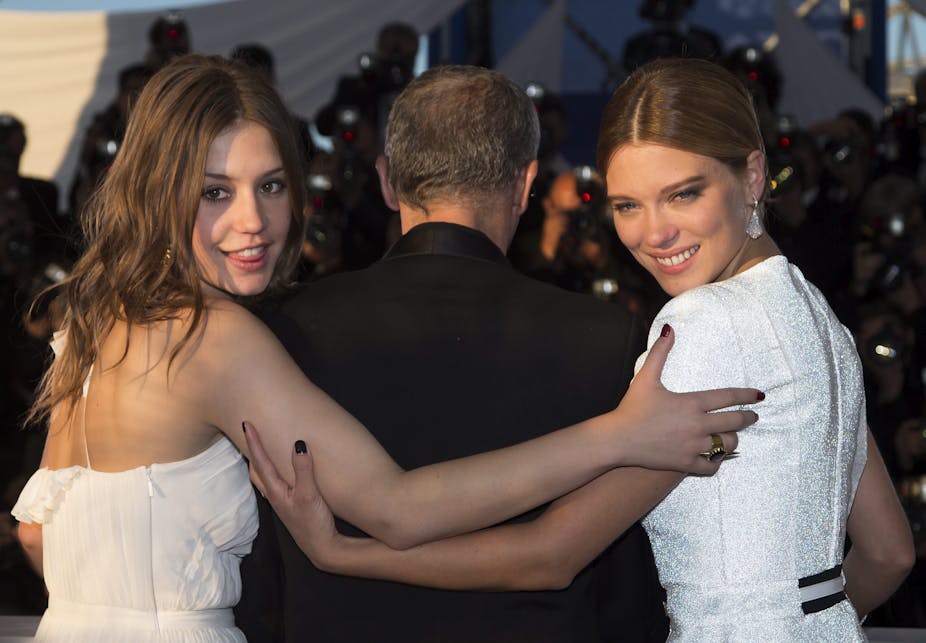From limited theatrical releases to the queer film festival circuit – and being refused classification – 2013 has seen films with LGBT content distributed to audiences by a variety of means.
Box office intake alone isn’t the sole indication of what makes a successful queer film. Success for queer cinema is also a complex interplay between social politics and the changing nature of the film industry.
Here are five notable queer films of 2013.
1. Stranger by the Lake (L'inconnu du lac)
Director: Alain Guiraudie
Set wholly within and around a shimmering lake in summertime France, Stranger by the Lake is a minimalist thriller. The main character Franck’s (Pierre Deladonchamps) repetitive attendance of a cruising ground introduces him to two very different men.
He converses with Henri (Patrick Dassumçao), a stout middle-aged gentleman who chooses to observe from the outskirts, and is charmed by the strapping Michel (Christophe Paou), who Franck witnesses drowning his lover.
Guiraudie’s film is both hypnotically beautiful and frank in its depiction of sex and deservedly won both the Queer Palm and the Un Certain Regard Directing Prize at this year’s Cannes Film Festival.
Much like a select few films preceding it, such as William Friedkin’s Cruising (1980), Stranger depicts murder occurring within the cruising scene. This film markedly differs from Cruising, however, in that it offers the perspective of the insider. By the time Franck is aware of the danger he is in, we too are very much within this community.
Screening at international film festivals, Stranger by the Lake also received a limited theatrical release.
2. I want your love
Director: Travis Matthews
While technically a 2012 film, Travis Matthew’s I Want Your Love was programmed in queer film festivals earlier this year until the Australian Classification Board refused its festival exemption due to explicit sexual content.
This blocked Australian queer film festivals from being able to screen the film. As a replacement the Melbourne Queer Film Festival programmed Matthews’ more recent film Interior. Leather Bar, which he directed with James Franco.
This incident raised pertinent questions about film censorship in Australia as many wanting to see this film ended up accessing it for free through pornographic sites online.
3. Concussion
Director: Stacie Passon
Rose Troche’s groundbreaking 1994 film Go Fish broke up the male dominance of the New Queer Cinema Wave of the early 1990s by being the first feature length lesbian-themed film to screen in competition at Sundance.
Produced by Troche, Concussion is a significantly different film. While Go Fish had a raw energy to it, Concussion is decidedly slicker. After a blow to the head Abby, a suburban lesbian mom, decides to lead a double life as a sex worker. In her directorial debut, Passon delivers a film that is a powerfully erotic critique of marriage and relationships.
4. Blue is the Warmest Colour (La vie d'Adèle)
Director: Abdellatif Kechiche
Although it won’t be released in Australia until February 2014, Palme d’Or-winning Blue is the Warmest Colour deserves a mention due to the sheer amount of discussion surrounding the film.
Lead actors Adele Exarchopoulos and Léa Seydoux have publicly complained about Kechiche’s working conditions, stating that it took ten days to shoot a 10-minute sex scene. This sex scene has dominated discussion of the film, with critics accusing the film of being pornographic and many lesbian audiences arguing this is a film made by a straight filmmaker and performed by straight women.
Posture, a New York based queer arts mag, invited queer-identifying women to respond to the scene, with many unsurprisingly stating how unrealistic and fetishistic the scene is. The dialogue surrounding this film raises two points of discussion – that of straight actors portraying queer roles and the very different nature of queer and straight audiences.
5. Valentine Road
Director: Marta Cunningham
Larry King, 14, was openly gay and exploring his gender expression through wearing heels, dresses and make up to school. In February 2008, Larry was shot and murdered by his classmate Brandon McInerney after he asked him to be his valentine.
Marta Cunningham’s film explores the world within which this tragedy occurred and the trial that followed. The film raises difficult topics, such as McInerney, a 14 year old, being tried as an adult and interview subjects feeling empathy for him. This is a heartbreaking but important film that deals with the devastating effects of homophobia and transphobia.
Valentine Road screened at various film festivals in Australia, including the Melbourne International Film Festival, and on HBO in the US in October for National Bullying Prevention Month.
There were significantly more films that could have been included in the above list.
But the scope of this article leaves only a select few for me to mention. Kill your Darlings sees Daniel Radcliffe play Allen Ginsberg; Gerontophilia is Bruce La Bruce’s latest offering; Behind the Candelabra aired on US television and was distributed theatrically in Australia; and I am Divine documented how Harris Glen Milstead became Divine, John Waters’ muse and an international drag icon.
2013 has been a strong year for queer cinema, demonstrating there is a clear market for films with LGBT content. The increasingly diverse content on offer is testament to this strong demand.

